Bridging Artists, Military, Veterans, and Civilian Communities
New England Foundation for the Arts (NEFA) collaborated with HowlRound to produce a convening inspired by artists and their collaborators in the military, veterans, healthcare, and presenter communities who created five new performance works funded by NEFA’s National Dance Project and National Theater Project:
- Healing Wars, led by Liz Lerman
- Speed Killed my Cousin, led by Linda Parris Bailey and Carpetbag Theater and directed by Andrea Assaf
- ReEntry, led by KJ Sanchez and American Records Theater
- Basetrack LIVE, led by Anne Hamburger and En Garde Productions
- to go again, led by Axis Dance Company and choreographed by Joe Goode
Encouraged by the deep learning in each of these works, NEFA saw an opportunity to increase the impact of the funded projects by convening stake holders for dialogue around practices and strategies. Supported by the Doris Duke Charitable Foundation, the Andrew W. Mellon Foundation and the National Endowment for the Arts, the three days of performances and conversations were documented to share knowledge and insights with a larger, growing field. Download this full report on the NEFA website, read other content on this topic, or watch sessions from the convening.
Overview
In March 2017, the New England Foundation for the Arts partnered with HowlRound to host a three-day convening, “Art in the Service of Understanding.” This unique event aimed to advance knowledge of the role of art in building bridges between military and civilian communities, frame methodologies for artist-military collaborations, and focus stakeholders on priorities for further investment in this field of work.
Over seventy-five participants attended, representing a range of backgrounds, professional areas, and relationships to the topic. They included active military personnel, veterans, artists, arts presenters, health care practitioners, and funders. Personal stories were used to welcome everyone fully into the space and allow all voices to be heard equally. Discussion was interwoven with artist performances, offering a vivid reminder of what this work is about and what is at stake.
Three key questions guided the convening participants in their discussions: What makes this work important? What makes this work successful? What will make it even better? An accounting of the challenges faced in this work also emerged. What follows is a summary of the rich and poignant conversations that occurred over the course of the three days.
What makes this work important?
Throughout the convening, participants discussed the myriad reasons for engaging with this work and the importance that it holds for individuals, communities, and society. They recognized art as a powerful force that can play many roles in the context of military communities:
Healing
There is no doubt that art can have a powerful healing effect for those touched by the trauma of war. It allows for an expressive mode beyond just talking, and is used as a tool to help process complex emotions. The convening had a particular focus on the performing arts, which generally contain an element of movement; it was noted that the physicality of a kinesthetic mode of expression can be a healing force in its own right.
Given that the performing arts place great emphasis on storytelling, much of the discussion centered on the power of both telling one’s own story and of listening to another’s story. One veteran spoke of how the stage offered the opportunity to reclaim and reframe their own narrative, and to put it out into the world. This sense of agency afforded by artistic expression was seen as crucial in shifting veterans to identifying—and being identified—as contributors rather than as victims.
This shift in identity was described as being key to resiliency. As one attendee noted, “Part of resilience is letting go of the looping tape of your hardship, and allowing fresh new perspective in.” Ultimately, this work is understood to be playing a part in saving people’s lives.
Civic Education
Participants acknowledged that the arts can play a role in promoting a kind of social and civic literacy among the wider population. Artistic practice can lead to learning between civilian and military groups, and in particular serve to help civilians understand the unique experience of those serving in the military. As one attendee observed, “There is something about the wartime experience that shakes us loose from the coma of twenty-first century life. It’s patronizing and shallow to see it as a window into veterans’ brokenness, but rather they have lived something that is valuable for us to understand.”
There is something about the wartime experience that shakes us loose from the coma of twenty-first century life. It’s patronizing and shallow to see it as a window into veterans’ brokenness, but rather they have lived something that is valuable for us to understand.

Because the true stories of war often go untold, the arts can become essential in the quest to make the invisible become visible. A recurring theme was the negative effect on the next generation when we don’t tell children about war. Also discussed was the fact that the stories coming out from veterans are important for the historical record, and as social commentary. As one artist put it, “We wanted to show the audience a war they were not seeing on TV. We wanted them to feel it, to have them walk out feeling they needed to do something.”
To this end, art was discussed as a catalyst for social action. The arts are very motivating, and an event such as an exhibit, display, or performance can be highly strategic. Thus, it was acknowledged that the arts have a potential role to play in political change and in shifting the dominant culture.
At its most profound level, art can be a springboard to deep societal discussions about moral and ethical questions: Why do we have such a culture of violence in this country? Why do we spend more on military than next seven countries combined? Why are we permanently at war? Why are our police militarized? Why do Americans feel comfortable with this? Participants discussed how as artists, they have an obligation to investigate these important moral issues.
Ultimately, art was seen to be a vehicle for shifting worldviews. Here again the idea that physical movement can shift someone into a new perspective arose, highlighting the power of kinesthetic experience, and of engaging an audience in movement as well. There is also a way in which art creates a container for collective exploration. As one participant said, “What allows war to occur is dehumanizing. The rehumanizing process is going to risky places together, and being afraid, and doing it anyway."
Bridge Building
A strongly recurring theme was the way in which art can create connections across difference. Participants discussed the power of artistic performance to address the gap between civilian and military communities. It was noted that the gulf between these two communities is “unacceptably wide,” and in fact dangerous, as it isolates the military and opens it up to misuse by those in power. There was strong agreement on the need to have conversations between these groups. Central to this is the idea that it is not about helping veterans, but rather about veterans helping to teach the community, and to bridge the gap.
Also discussed was the ability of the arts to create empathy across disparate communities, such as Iraq veterans and Iraqi refugees. Prominent was the notion that sharing stories brings us closer together, including with those who can’t tell their own stories—death being the ultimate divide that art can bridge.
Connections across race and gender lines were also lifted up as an outcome of veterans’ arts programs. One participant described how they have incredible diversity in their writing groups (over 50 percent people of color, and 40 percent women) because writing is highly accessible. In this way, the arts are reaching more underrepresented populations and providing different communities with the tools for expression.
Because it creates a shared experience, art can also be an important springboard for collective exploration. In the words of one participant, “As a presenter, I feel successful when I get people in a room that wouldn’t otherwise be in a room together, and they have a transformational discussion. Community transformation is happening. My work in a presenter role is to have my own worldview, and make space for all the folks who don’t have the same worldview as me so that something can shift.”
Reflecting the Human Condition
The creation of art and the creation of war are both part of what it is to be human.
Time and again, the conversation returned to the notion that the arts and artistic creation in this context lead to a profound reflection on the human condition. While there is indeed a gap between military and civilian communities, the two are also bound by their shared humanity and the universality of the effects of trauma.
Some participants asked, what’s the difference between Sandy Hook, Fallujah, and communities facing police violence? Regardless of the cause, the physiology and psychology of the response are the same. In this way, veterans have valuable knowledge about a significant part of the human experience.
For the participants who were familiar with military history, the relevance of veteran stories and experiences across time was seen as pertinent. In a sense, there are no new stories. The stories of those who serve are both individual and universal, and they highlight experiences common to all of us: pain, loss, suffering, growth, resiliency, a desire to feel part of something larger than yourself. As one participant beautifully noted, “That magical dance between the particular and universal is what’s powerful about this work.”
What makes this work challenging?
While there is no question as to this work’s importance, it is not to say that it is always easy. The discussion frequently touched on the myriad challenges faced by practitioners:
The Culture Gap
Over and over again participants pointed out that military culture differs greatly from civilian culture, and the ways in which that presents difficulty. Adding further complexity is the fact that each branch of the military has its own particular subculture, making cultural competency in this field even harder to achieve.
Language was often cited as a significant element of the culture gap. This ranged from the need to learn military jargon, to a story of mistakenly using the expression “stepping on toes” with an amputee who has no toes. Communication styles also came into play—for example, asking a veteran to do something exploratory, rather than giving clear instructions, is a cultural shift for them. In seeing a story translated to the stage, military folks tend to favor accuracy and precision, whereas that might cause nonmilitary audiences to lose the story somewhat. Negotiating and translating between the two cultures is continually needed.
Many practitioners also spoke of having to break through a “code of silence” when working with veterans. Some vets felt that military culture dissuaded them from talking about their experiences, and described needing to reach a point where they realized they could give themselves permission to tell their own story. This silence sometimes extends to military families as well—one presenter described an audience of 750 students, three-quarters of whom had loved ones in the military, and yet almost none of them were willing to talk about it.
An additional cultural barrier that was identified relates to the military’s culture of service. Because of this service mindset, many veterans do not want to be given things. According to one participant, “warrior culture is not to receive care.”
Issues of Representation
Participants noted that there is a difference between being trusted with someone’s story and with how that story is then presented onstage. Some artists engaged with this tension by putting unfinished work out for feedback, which was seen as both risky and helpful. Others used an approach of “witnessing” stories—using interview text verbatim—rather than representing the stories. Some also pointed to the wider implications of artistic representation—how, for example, the oversaturation of images of PTSD on stage can cause inadvertent harm by leading to lower employment rates for returning veterans.
The discussion included a recognition that certain stories are underrepresented in this field—for example, the unique experiences of women and people of color in the military. In particular, there remains a difficulty around expressing stories of sexual assault. It was acknowledged that there is a danger in universalizing the experience of those who serve in the military, and that artists should take care to avoid that approach.
The Risks of Working with Trauma
Given the prevalence of trauma in military communities, much of the conversation centered on questions of what responsibilities art practitioners should bear in this context. When working with trauma victims, how much is too much? What is too safe? It is indeed possible to be either too cautious, or not cautious enough. This poses a dilemma for the art community, which is often striving to get into emotional material while not re-opening psychological wounds.
‘When working with trauma victims, how much is too much? What is too safe? It is indeed possible to be either too cautious, or not cautious enough.’
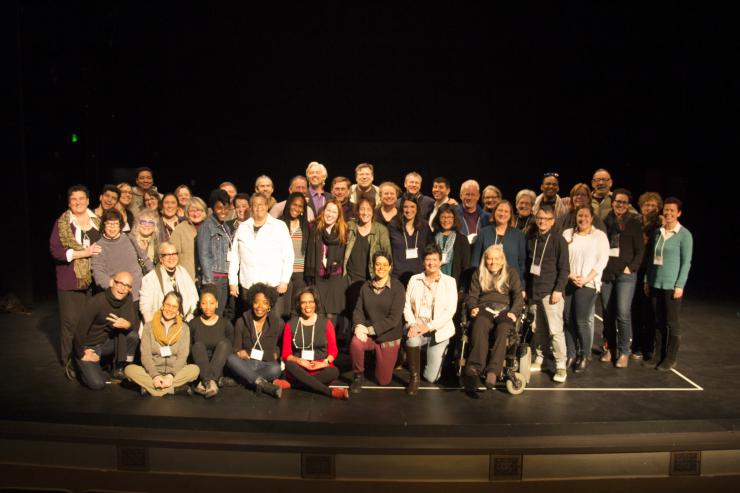
Participants acknowledged that at times having a licensed therapist on hand was crucial to the ability to work safely with veterans, while at other times a therapist in the room can actually create a barrier to building trust. Ultimately, it was agreed that practitioners should have some level of training, and should identify additional resources before they are needed. It is important to get informed consent, and to be sure people have an idea of what they are about to embark on.
Lack of Clarity Around Goals
While participants shared general sentiments as to why this work is important, they also raised concerns about goals that are not always clear. What is each organization and initiative trying to accomplish? Who is the audience? How can the impact best be articulated and measured? Given that “form follows function,” a lack of clarity around these strategic questions might lead to a mismatch between the chosen approach and the intended outcomes.
A related question was whether or not there should be goals related to the quality of the art produced in this context. Is this work about the process, or about the product? Is quality important? If so, how is it being defined? What should our standards be? These were some of the questions that were raised, but that went unanswered.
What makes this work successful?
Despite the various challenges, there are numerous examples of success in this field. Convening participants discussed the factors that are likely to lead to a successful outcome:
An Intentional Framework
The range of approaches to this work is large, and the examples discussed included a diversity of art forms, venues, scales, settings, and processes. Seemingly, there are as many different journeys to sharing military stories as there are stories to be shared. What does seem critical is being thoughtful and intentional as practitioners in how the work is carried out.
Central to all of the successful frameworks was the intent of creating spaces where learning and mutuality can happen. Framing a process around the power of listening allows vets to understand that they are helping each other by listening to one another’s stories. These types of peer-to-peer connections were highlighted as something that furthers the healing process. Frameworks that allowed practitioners to “meet people where they are” were also seen as more effective.
Participants also spoke to the importance of frameworks that embody the belief that everyone is creative and capable artistically, and that are mindful of the need for self-care for performers.
Strong Relationships
Perhaps no other theme was as prevalent as that of the need to develop strong relationships. Relationship building was seen as absolutely key for success in this work, and for fostering accountability and ensuring the long-term sustainability of an initiative.
Participants highlighted the value of having designated intermediaries in a community who can act as channels of communication across groups. Also discussed was the need for these intermediaries to have cultural competency around the multiple and complex sub-cultures within the military. A good intermediary will understand that military communities are not monolithic, and can help to bridge the cultural gaps.
Relationship building was also seen as critical to identifying a potential “safety net” for veterans who may be suffering from trauma. Practitioners were encouraged to understand the landscape within which they are working, and to reach out to their potential resource partners before beginning to work in a particular community.
Transparency and Trust
Related to the task of building relationships is the importance of fostering transparency and trust within those relationships. Participants stressed the importance of talking about one’s own motives for wanting to be involved in veterans’ stories, and of asking vets to share their reasoning for wanting to reveal their stories. Practitioners should be clear and upfront about what their goals are for the project: is it about healing, or about something else?
Also important is taking care to inform people about potential triggers and letting them choose what they want to see. Time and thought should be put into letting folks know what they are being invited into.
Over and over again participants spoke to the amount of time it takes to build trust and credibility with stakeholders. Once vets began to trust that practitioners were not going to go away (which sometimes took years), they began to be more open with their stories. Consistency was also named as a key factor in success, although it was acknowledged that longer-term projects or ongoing programs face a trade-off with the number of touches involved.
High Levels of Engagement
Another common theme was the notion of fostering high levels of engagement within the artistic process. Convening participant and artist Liz Lerman demonstrated how her company’s work Healing Wars involved active audience participation. Audience and community engagement can also extend to the pre- and post-production phases of a work of art. Some participants found that audience engagement worked best when the audience was a mix of both military members and civilians.
‘I’ve found it easier to bring veterans onto a stage or into a studio than into an audience.’
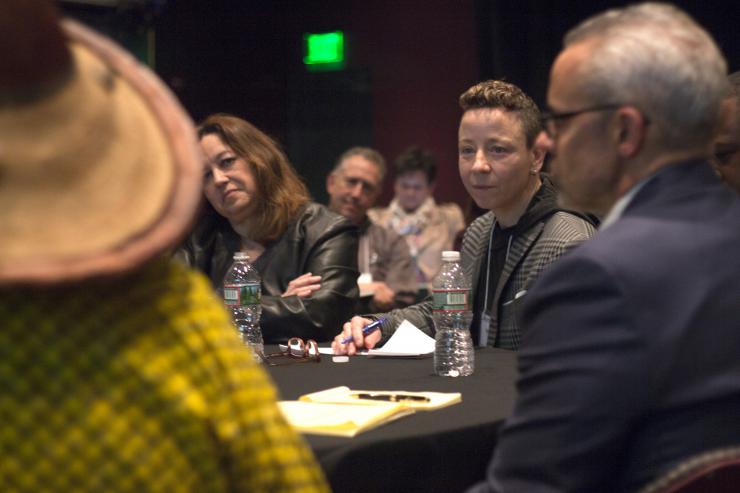
A major point of discussion was the belief that this work is most successful when veterans are engaged as artists, not merely as audience members. As one participant explained, “I’ve found it easier to bring veterans onto a stage or into a studio than into an audience. It’s about agency, having a sense of control. When you are out there in the dark, you are alone among people, passive, you don’t have your gun or your tools; when you are on stage, you are modulating what is going on, you are taking control of the situation.”
Also noted was the need to engage not just veterans, but military dependents as well. The spouses and children of service members have a need to be included in the conversation, as do other caregivers.
Recommendations:
In light of the discussion themes that emerged at the convening, the following actions are recommended:
Define Goals and Measure Impact
The field would benefit greatly from encouraging all practitioners to clearly define goals and desired outcomes for each initiative. To this end, it will likely need to engage with the questions that it seemed to shy away from at the convening: Is this work politically neutral? Should it be? If not, to what end?
Evaluation and impact measurement are also important for making the case as to the value of this work. Participants suggested that medical research should be included in impact analysis to the extent possible.
Build a Learning Network
The building of cross-sector relationships was seen as key to this work. The field should undertake an effort to map and build a strong learning network. Specific actions could include creating mentorship opportunities for new artists; preparing case studies of various initiatives; assembling a “toolkit” that includes resources and best practices; creating an online platform for discussion and sharing; and organizing a follow-up convening.
The field should undertake an effort to map and build a strong learning network.

Participants expressed a desire for the emerging network to include visual, as well as performing artists. It was also pointed out that the disability community is an untapped resource, and that the field could benefit by connecting with independent living centers and folks who have been navigating disability and accessibility issues for a long time.
Increase Engagement and Visibility
Several participants pointed to the need for a national media strategy that would help to raise the visibility of this work. This could include a strategy for reframing the perspective people have of veterans, bringing forward stories of strength and resilience rather than trauma and damage. Also discussed was the desire to put this work on the agenda of more institutions.
Invest Resources for Long-Term Sustainability
Because this work appears to be most successful when there is a long-term commitment, resources should be allocated to initiatives with a lengthy trajectory in mind. As one practitioner pointed out, their success “didn’t happen on the grant timetable.” Funding and nonfinancial support for artist residencies, ongoing programming, network building, and projects with long time horizons will be crucial to the future success of the field.

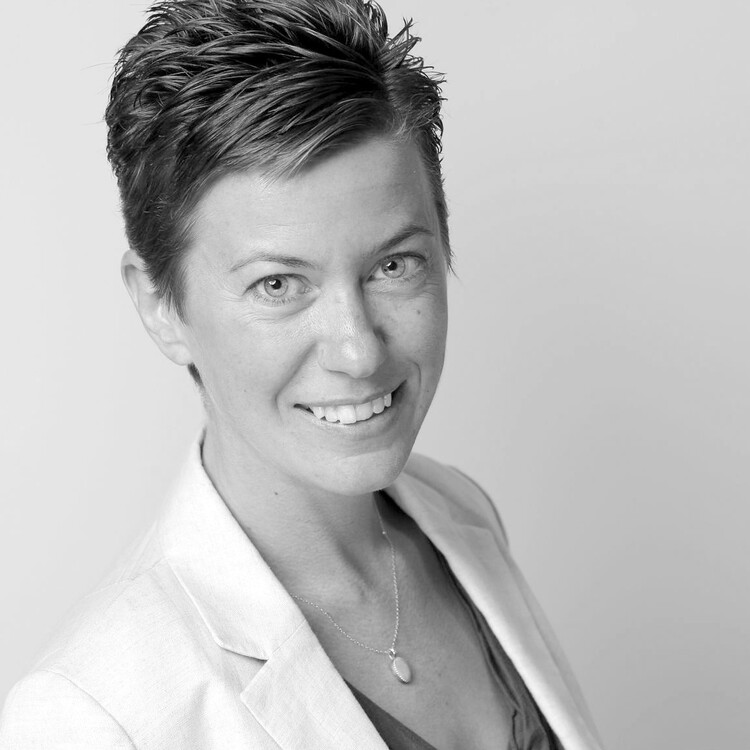

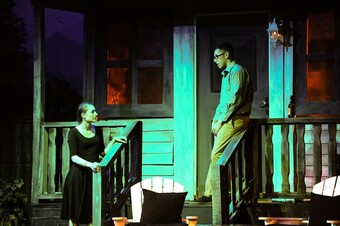

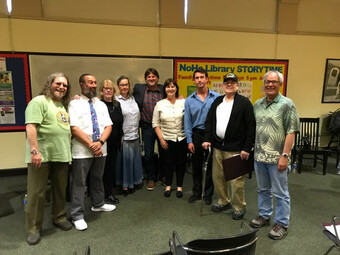



Comments
The article is just the start of the conversation—we want to know what you think about this subject, too! HowlRound is a space for knowledge-sharing, and we welcome spirited, thoughtful, and on-topic dialogue. Find our full comments policy here